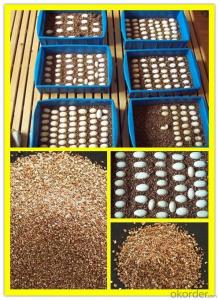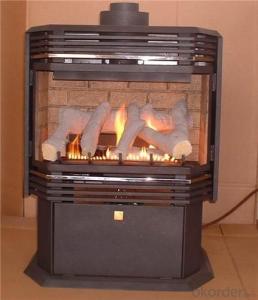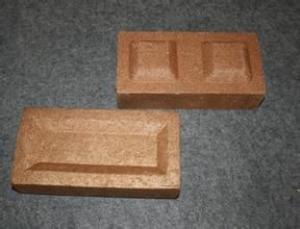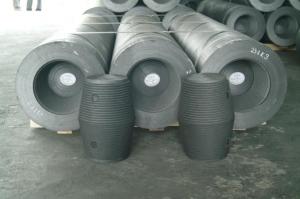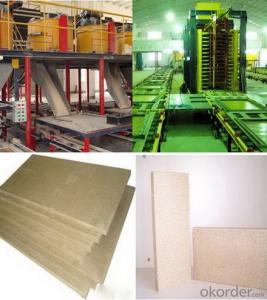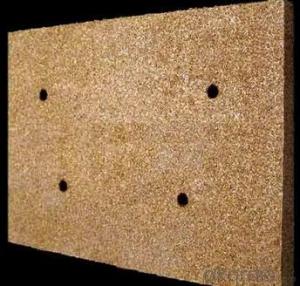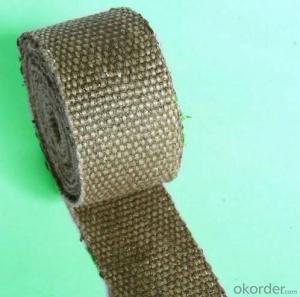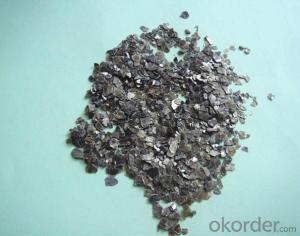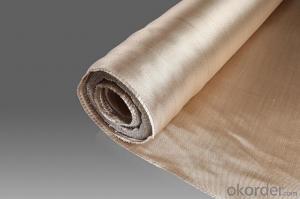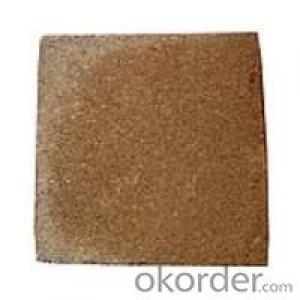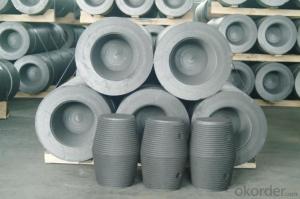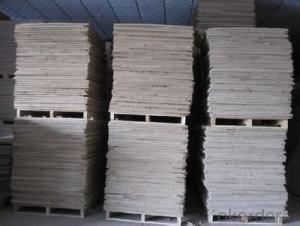agriculture 0.3-1mm gold vermiculite
- Loading Port:
- Tianjin
- Payment Terms:
- TT OR LC
- Min Order Qty:
- 20 m.t.
- Supply Capability:
- 1000 m.t./month
OKorder Service Pledge
OKorder Financial Service
You Might Also Like
Packaging & Delivery
| Packaging Detail: | 1.2ton/bag |
| Delivery Detail: | 15days |
Specifications
SGS passed
used for agriculture
Typical chemical analysis:
element | Percent by weight (%) |
SiO2 | 37-42 |
Al2O3 | 9-17 |
MgO | 11-23 |
CaO | 1-2 |
K2O | 5-8 |
Fe2O3 | 3.5-18 |
H2O | 7-18 |
Typical chemical formula:
(Mg, Ca, K, Fe11)3(Si, Al, Fe111)4O10(OH)2O4H2O
Typical physical properties:
Density | 220-270kg/m3 |
Porosity | 1100-1200kg/m3 |
Hardness | 1-1.5 |
Melting point | 1320-1370 |
Compressive ressitance | 100-150mpa |
Index of refraction | Ng=1.525-1.561 Ng=1.545-1.581 |
Moisture content | 7% |
Moisture absorbency | <2% |
Applications:
construction | 1. fireproof board |
2. loose fill insulation | |
3. construction coating | |
4. lightweight concrete | |
5. vermiculite plaster | |
industry | 1. thermal insulation, refractory |
2. sound absorption loose filling | |
3. friction linings | |
4 gaskets or seals | |
5. packing materials | |
agriculture | 1. horticulture |
2. soil improvement | |
3. fertilizer carrier | |
4. hydroponics | |
5. animal feedstuffs |
Samples are available.
Products are to be produced as per samples confirmed. Quality checking is done in the factory by our QC team and clients/or a third party named by clients.
Price is negotiable based on specification, quantity, delivering time etc…
- Q:It probably is and I‘m really upset about it.So my lizard laid the egg in the sand and I carefully moved it into a little plastic container. I used Vermiculite for the substrate, added a little water to it to not make it dry, and placed it in the same catch as my leopard geckos. ( It has a top on it )The thing that get‘s me thinking that it‘s already bad, is that it seems like it has a cut in it or something- kind of like it‘s leaking. The colour is clearish white and I don‘t know what to do about it. Please help. :(
- If the egg has a cut in it and is the white is leaking out, it will not hatch.
- Q:I had a philodendron plant in my house. I decided to put it outside. The wind knocked it over. Some of the plants stem is bent and broken, so I cut it off. The ‘cutting‘ I salvaged has no roots, it‘s all in the soil. I placed the philodendron in water, hoping it will grow new roots. Is there anything else I should do? (I don‘t have a picture of it)
- One of the reasons for philodendrons' popularity is their ease of propagation. Cuttings taken from the growing tips root readily in potting soil, vermiculite or water. This method works well for vining forms that have pronounced growth nodes -- the bumpy areas where leaves or aerial roots grow. During a period when the plant is actively growing, take 6-inch cuttings from the tips of the plant. Remove leaves away from two or three nodes at the bottom of the cutting, leaving one or two leaves on the growing tip, and sink it into moist media or water. Roots should begin forming within 10 days to three weeks. Plants have individual habits that control their readiness to form new roots, but keeping them in a bright, but not sunny, window where temperature ranges are 70 to 75 degrees Fahrenheit during the daytime and 55 to 60 degrees at night provides optimum conditions for a fast start.
- Q:What material is vermiculite?
- Vermiculite is a natural, non-toxic mineral that expands at high temperatures. It is a relatively rare mineral, belonging to silicates.
- Q:Bought a female bearded dragon a month and half ago from an aquarium place, no one informed us she was expecting, came home and there is a bunch of eggs in her tank, don‘t know when she had them but apparently some time today, don‘t have and incubator or anything like vermiculite, or sand to use wondering what else i could use and if the eggs are okay and if not what can i do about them as every site says not to throw eggs in the garbage not that I want i‘m just not familiar with the hatching process.
- if you didn't know the eggs are probably infertile.
- Q:Any easy ways or idea‘s how to make an home made Incubation for my leopard gecko‘s egg?? She hasn‘t had them yet but she is showing signs of pregnancie. Any one help me out???Thanks alot, Linden
- use a low wattage globe(25W). put it under a steel baking tray/dish in the bottom of your enclosure, cover the tray with sand and stones. plug the lights cord into a dimmer switch so it can be turned up or down to adjust the temperature. I must warn you about electricity and fire hazards. No water around electricity and no flammable materials around any heat source.
- Q:what are some exotic animals that i could realistically keep as a pet, and where can i buy them?
- My suggestion would be Emperor scorpions. They are exotic, giant, and nearly harmless. They are extremely cheap, easy to care for (a dozen crickets every 2 weeks or so and some water in a dish, with some vermiculite or woodchips as a base (thick enough for them to burrow under, if they want to, something for them to hide under (half coconut shell works great, as does half-cut PVC piping.) Virtually no maintenance, aside from feeding and changing the vermiculite once every few months. Never have fewer than 2, or they become territorial and hostile and way harder to pick up (and if picking one up is too freaky, scratch the whole idea. I've had 8 scorpions over the period of about 7 years and never got stung once). The best part is, if you're lazy, like I am, they can go for a month or so without food or water if they have to. It's not a good idea to do that, but I merely mean that you can let them go for a few days without having a house-sitter like you would with a mammal or bird. Plus, you look like a badass when you hold one in your hand. *a negligible point, but a valid one, nonetheless*. As to where you can get them, almost any good pet store should have a few.
- Q:i have 18, 17 day old eggs incubating and i noticed that the vermiculite was a bit dry the other day and wanted to know how would i make it a bit more damp without getting the eggs wet. when i got the vermiculite ready i made sure it was just right but over the last 17 days its got a bit dryer? . also i have noticed that some Of the eggs are larger than the others is this normal? many thanks
- I honestly can't help with vermiculite, but I can make a suggestion. try using hatch-rite (which can be purchased online from most reptile supply sites) and peat (which can be purchased at most gardening centers). You might also want to get a small scale. Use about 30 grams of peat, 30 grams of hatch-rite, and 40 grams of water. Then just get a spray bottle, set it to mist, and spray the lid of the hatching container a couple of times every few days. It is a very effective hatching medium.
- Q:I‘m new to growing microgreens and have tried Mel‘s mix and straight vermiculite, but a neighbor suggested cheap clay cat litter, which is what he uses to start bamboo from seed. Any suggestions on a good growing medum for microgreens would be most welcome. I like the mat idea but they are expensive for a one use product in my opinion. Thanks!
- No, clay cat litter is not a good choice for growing microgreens. When clay becomes saturated, it loses its pore space. Clay is the smallest part of soil. Clay particles can only be seen individually under an electron microscope. The other components to soil are silt, which are medium sized particles, and sand which are large particles. Good soil needs all three in certain amounts. This is soil science and can get pretty technical. To grow microgreens, you'd be better off with a good growing soil that holds some water but drains easily. It will have a good mineral base with a good amount of composted organic matter. The compost will supply basically all the nutrients the greens will need.
- Q:I have discovered an insulation underneath the blown in fiberglass that is a gray/brownish color that is underneath the fiberglass. Also, if you shine a flashlight at this insulation you can see tiny straight fibers within the insulation itself. Do any of you contractors, electricians, or diy‘ers know whether or not loose fill amosite asbestos was ever used in this form. The only other thing that I can think of that it might be is a rock or slag wool insulation, but I don‘t think that you can see individual fiber strands within that type of insulation though. The apartment in question was built during the late 1960s if that provides any insight to this question.
- Best answer is never say never, people can do the strangest things and a previous occupant may have been a boiler lagger in the 1960s and brought his work home with him. The ONLY way to be certain is to get it tested by an expert under a microscope as to my knowledge there is no other way of telling.Do not disturb this substance until you have had it tested and preferably get them to come to you.
1. Manufacturer Overview |
|
|---|---|
| Location | |
| Year Established | |
| Annual Output Value | |
| Main Markets | |
| Company Certifications | |
2. Manufacturer Certificates |
|
|---|---|
| a) Certification Name | |
| Range | |
| Reference | |
| Validity Period | |
3. Manufacturer Capability |
|
|---|---|
| a)Trade Capacity | |
| Nearest Port | |
| Export Percentage | |
| No.of Employees in Trade Department | |
| Language Spoken: | |
| b)Factory Information | |
| Factory Size: | |
| No. of Production Lines | |
| Contract Manufacturing | |
| Product Price Range | |
Send your message to us
agriculture 0.3-1mm gold vermiculite
- Loading Port:
- Tianjin
- Payment Terms:
- TT OR LC
- Min Order Qty:
- 20 m.t.
- Supply Capability:
- 1000 m.t./month
OKorder Service Pledge
OKorder Financial Service
Similar products
New products
Hot products
Related keywords
